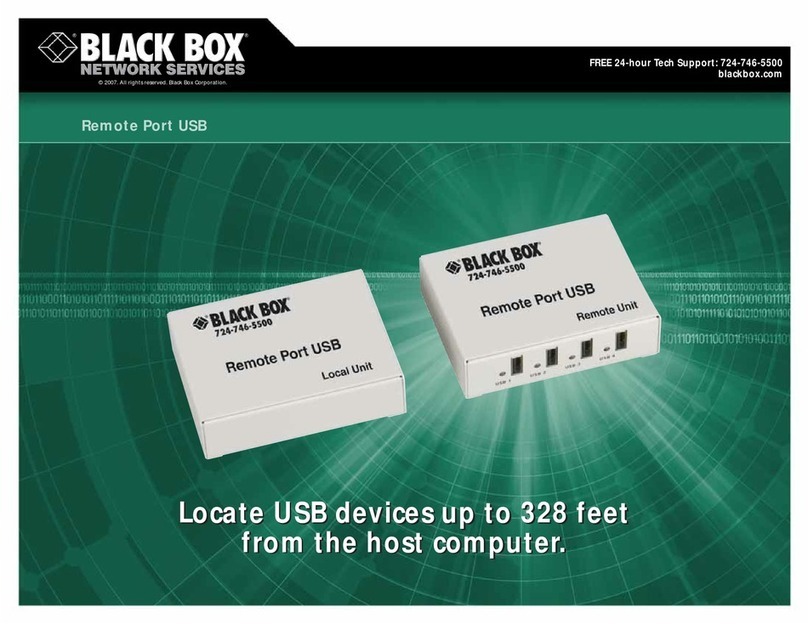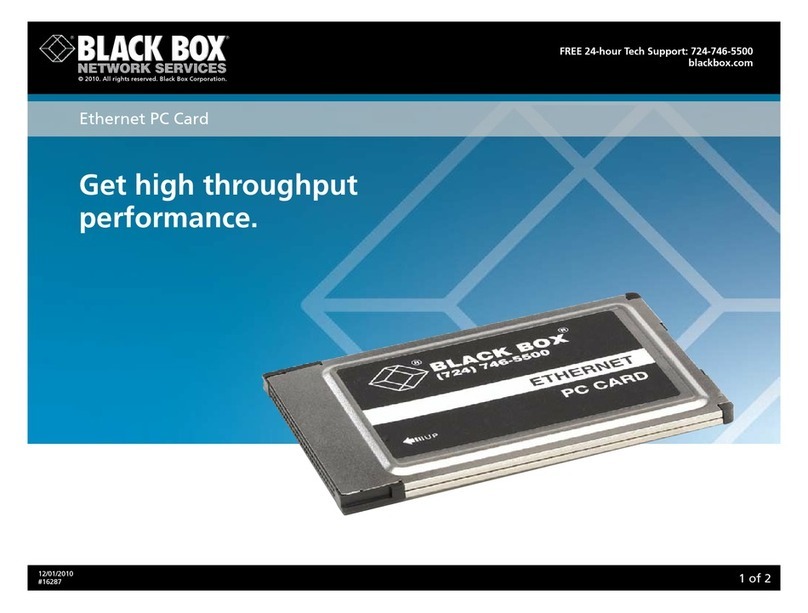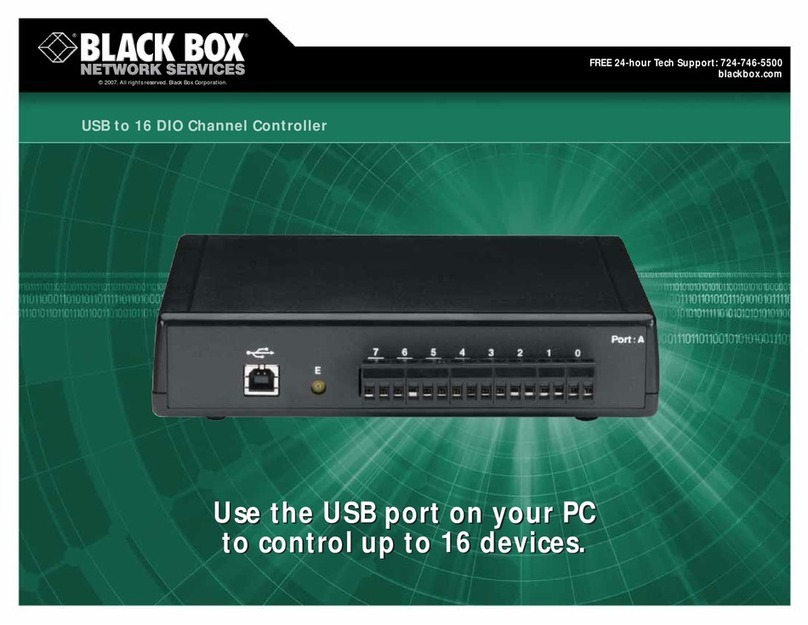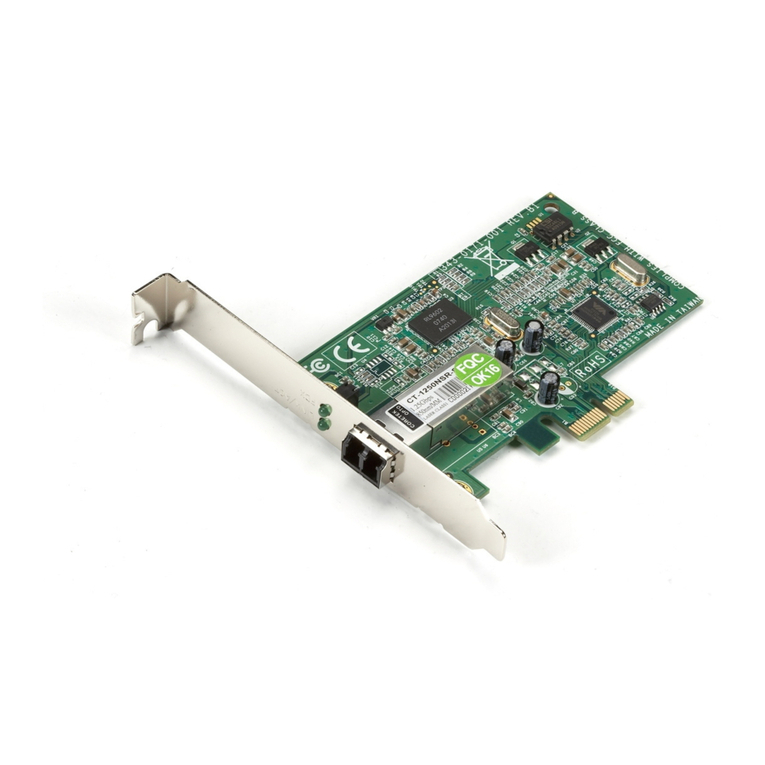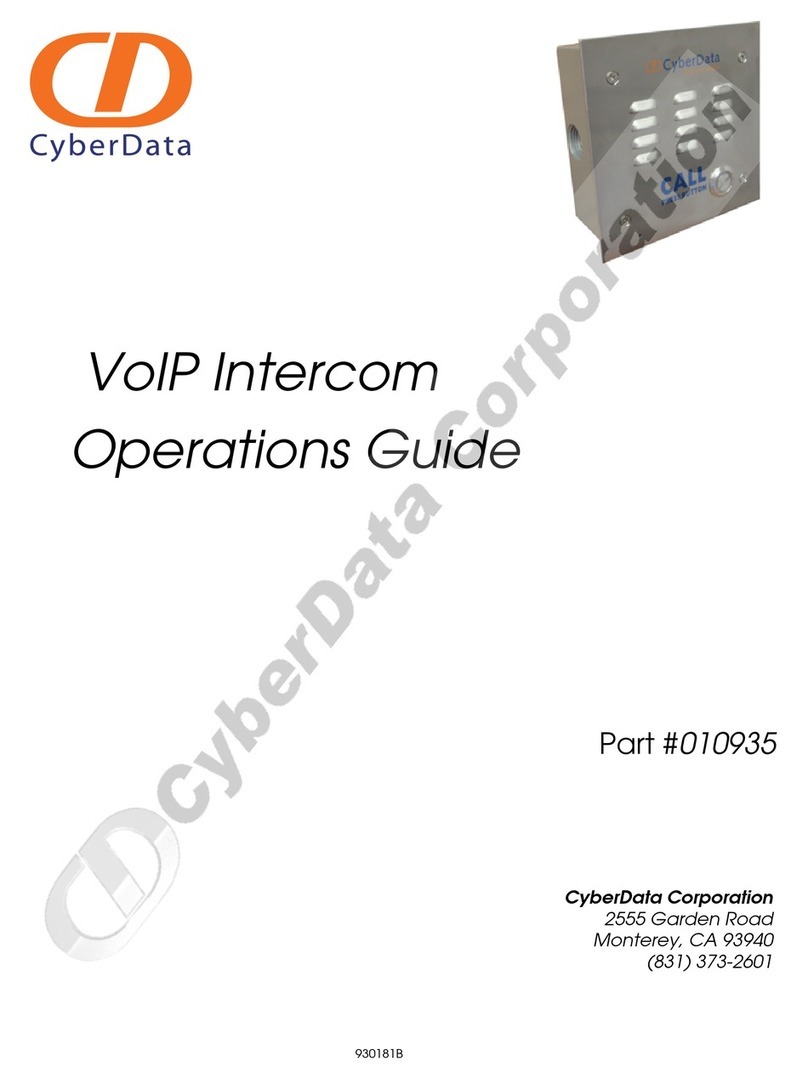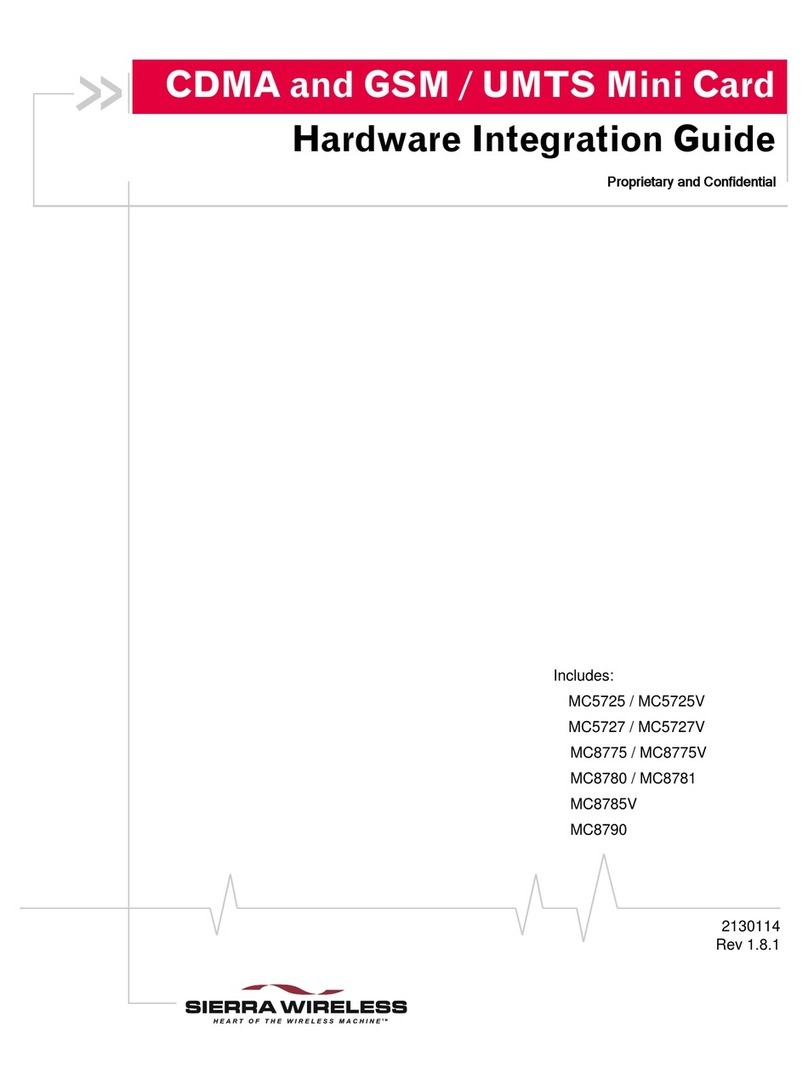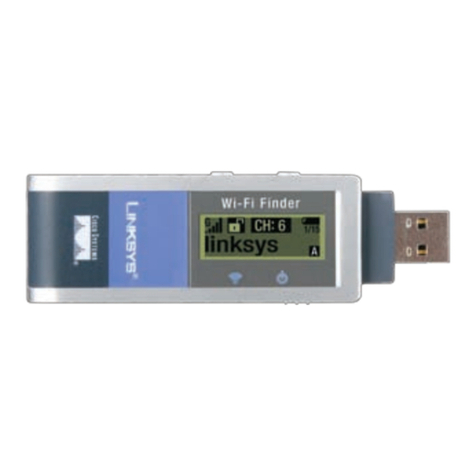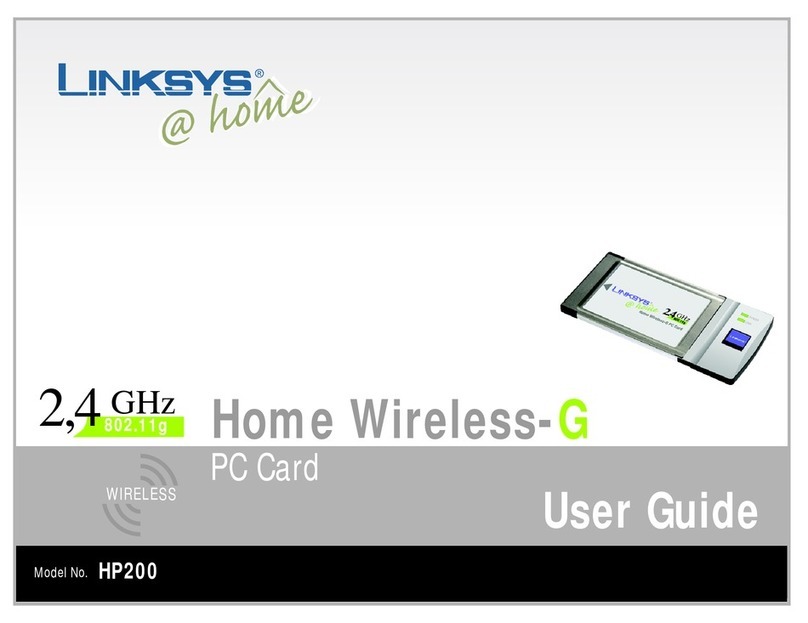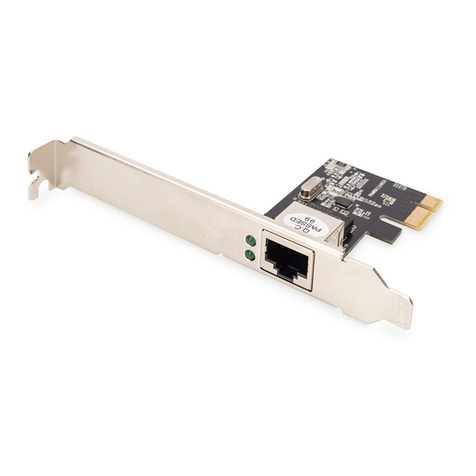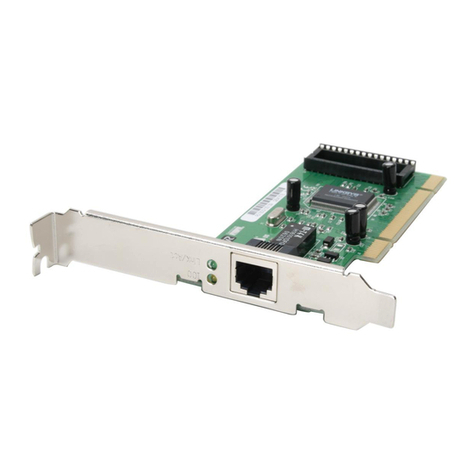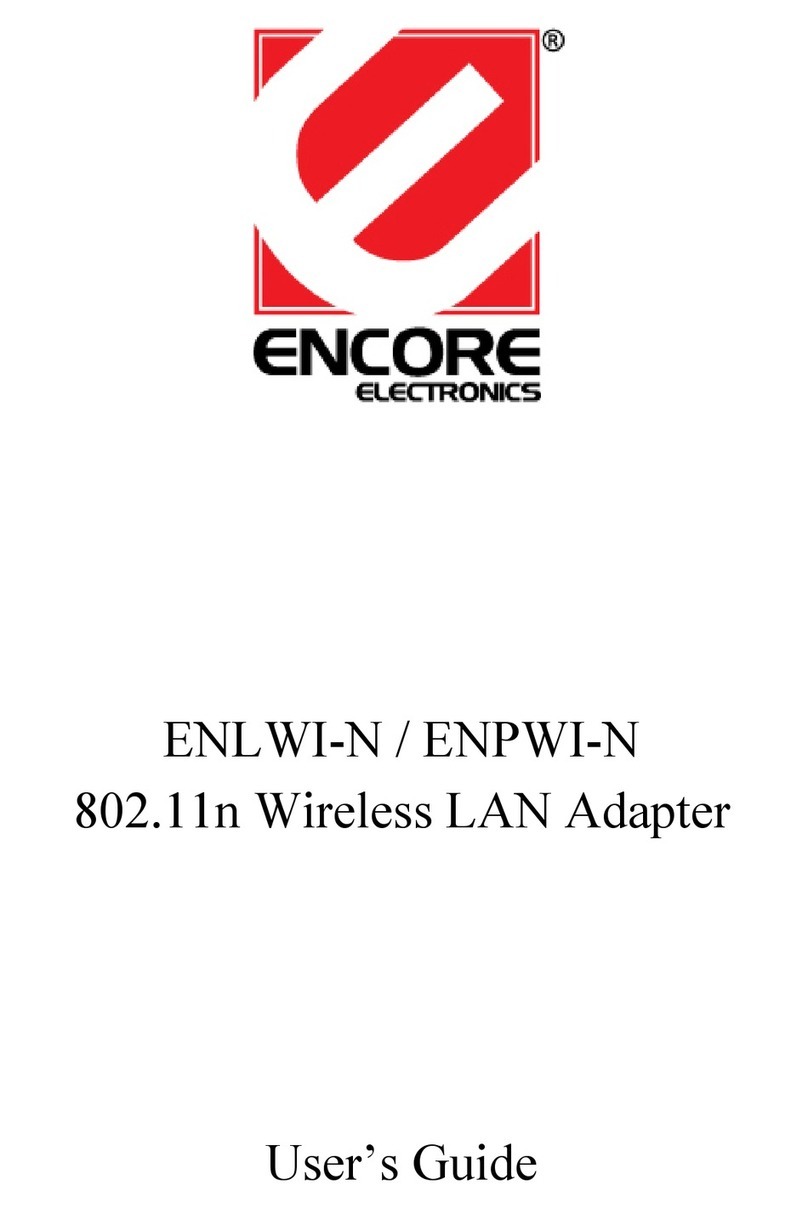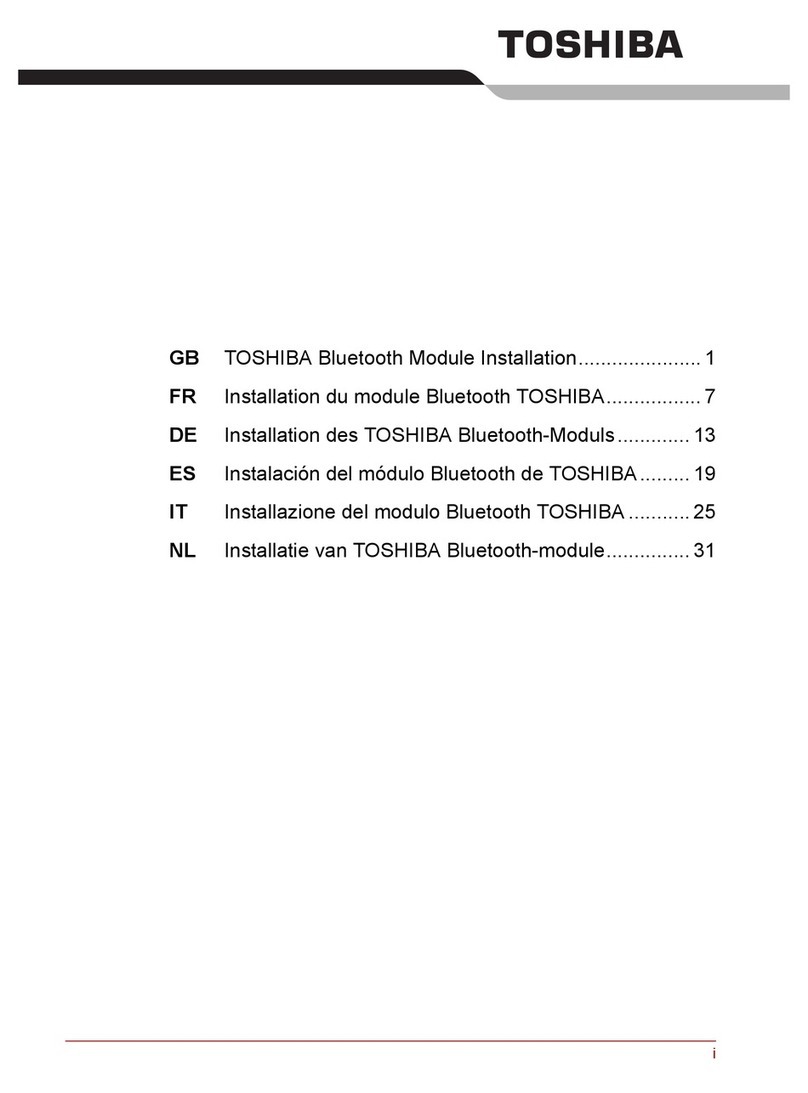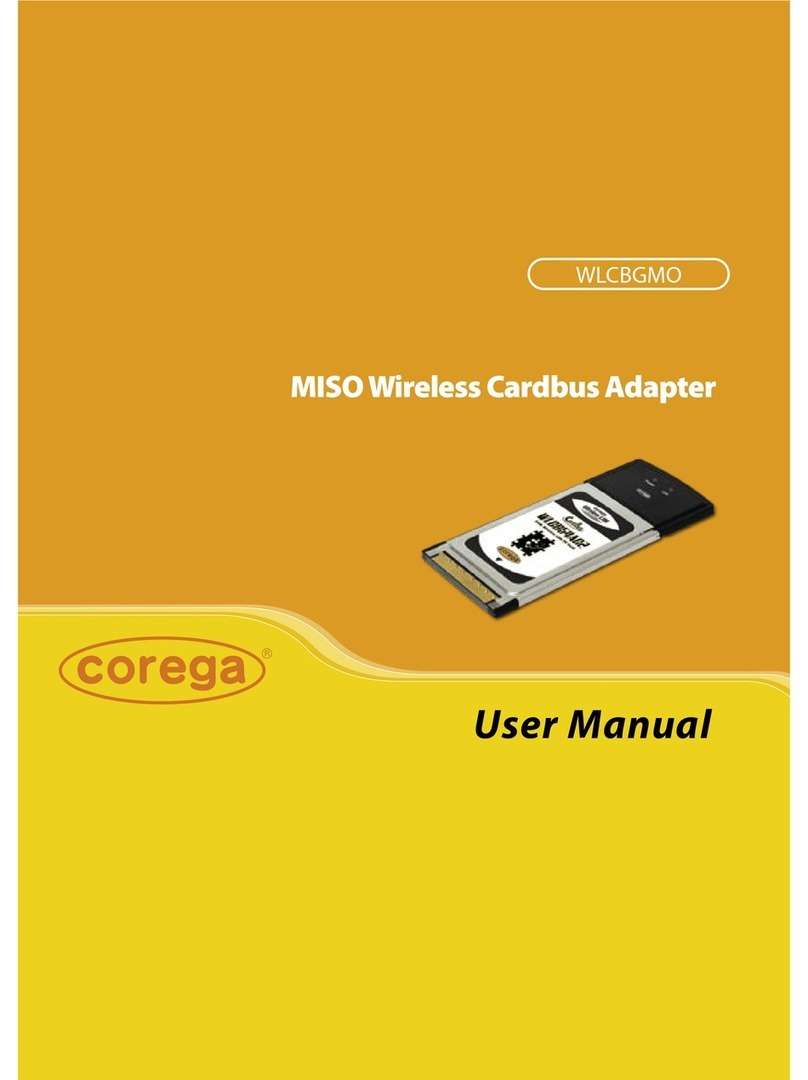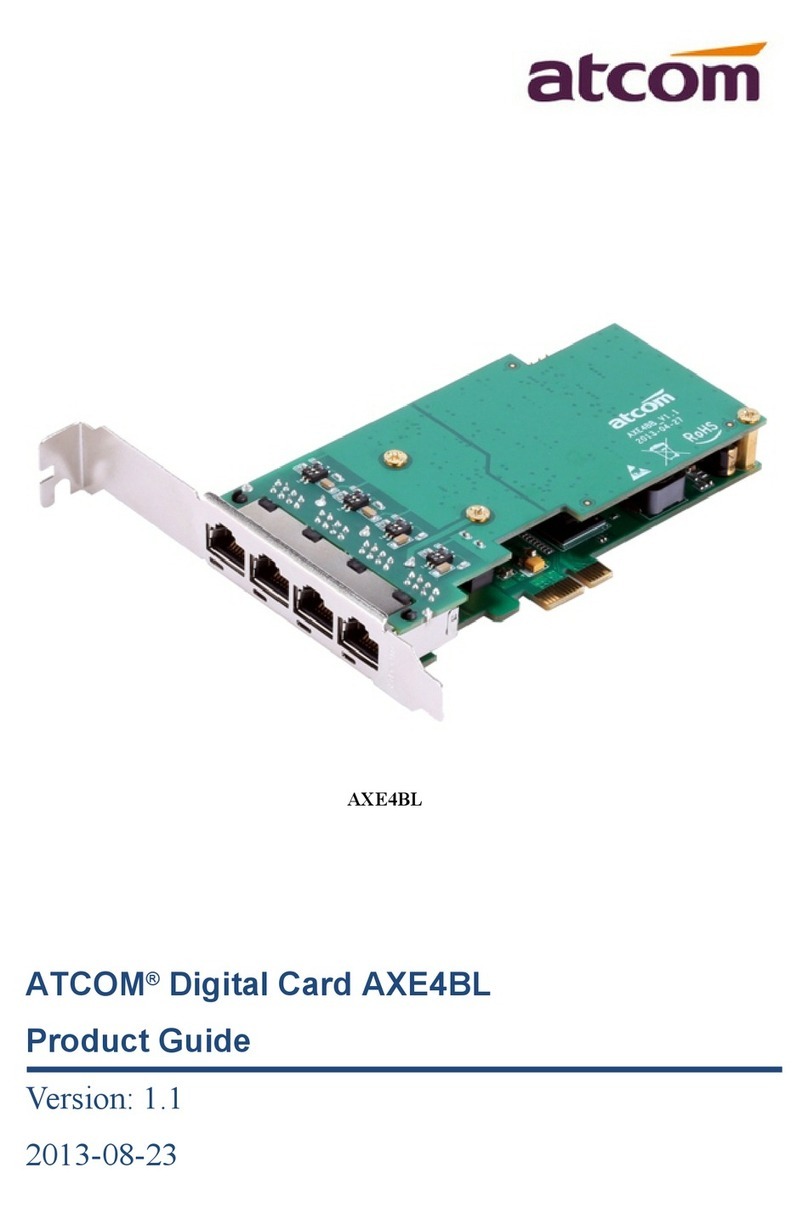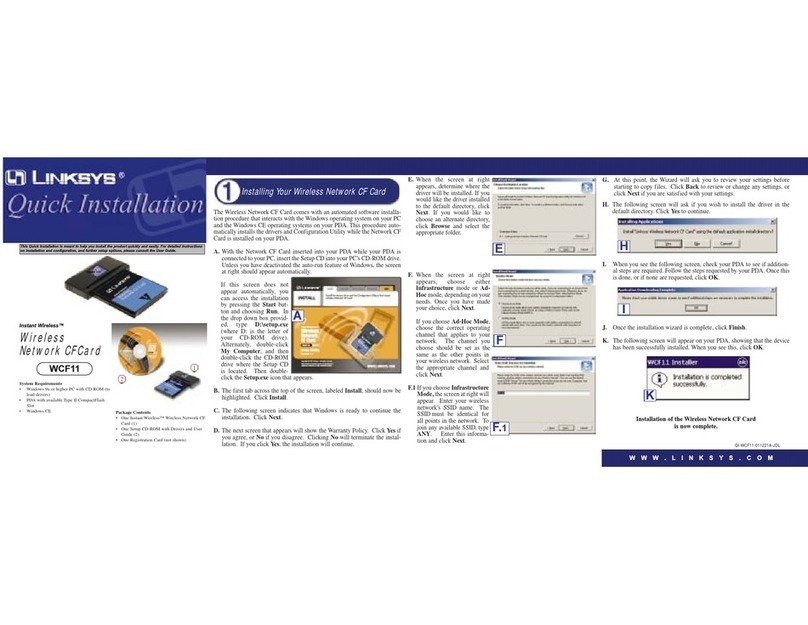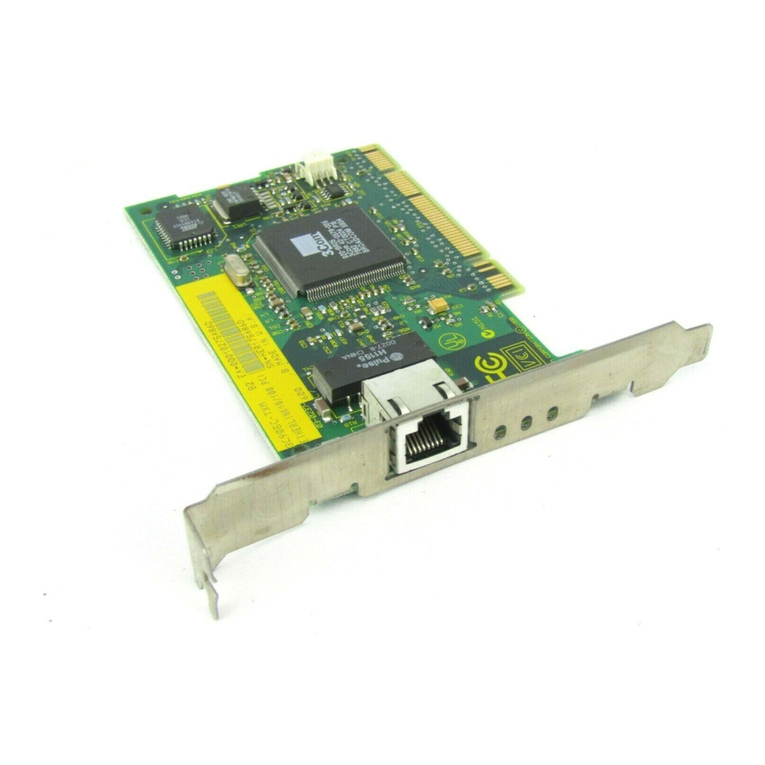Black Box LCL931A User manual

CityLIGHT® Fibre Channel Card
FEBRUARY 2001
LCL931A
LCL932A
LCL933A
LCL934A
Order toll-free in the U.S. 24 hours, 7 A.M. Monday to midnight Friday: 877-877-BBOX
FREE technical support, 24 hours a day, 7 days a week: Call 724-746-5500 or fax 724-746-0746
Mail order: Black Box Corporation, 1000 Park Drive, Lawrence, PA 15055-1018
CUSTOMER
SUPPORT
INFORMATION

CITYLIGHT FIBRE CHANNEL CARD
2
FEDERAL COMMUNICATIONS COMMISSION
AND
CANADIAN DEPARTMENT OF COMMUNICATIONS
RADIO FREQUENCY INTERFERENCE STATEMENTS
This equipment generates, uses, and can radiate radio frequency energy and if
not installed and used properly, that is, in strict accordance with the
manufacturer’s instructions, may cause interference to radio communication. It
has been tested and found to comply with the limits for a Class A computing
device in accordance with the specifications in Subpart J of Part 15 of FCC rules,
which are designed to provide reasonable protection against such interference
when the equipment is operated in a commercial environment. Operation of this
equipment in a residential area is likely to cause interference, in which case the
user at his own expense will be required to take whatever measures may be
necessary to correct the interference.
Changes or modifications not expressly approved by the party responsible for
compliance could void the user’s authority to operate the equipment.
This digital apparatus does not exceed the Class A limits for radio noise emission
from digital apparatus set out in the Radio Interference Regulation of the
Canadian Department of Communications.
Le présent appareil numérique n’émet pas de bruits radioélectriques dépassant
les limites applicables aux appareils numériques de la classe A prescrites dans le
Règlement sur le brouillage radioélectrique publié par le ministère des
Communications du Canada

CITYLIGHT FIBRE CHANNEL CARD
3
NORMAS OFICIALES MEXICANAS (NOM)
ELECTRICAL SAFETY STATEMENT
INSTRUCCIONES DE SEGURIDAD
1. Todas las instrucciones de seguridad y operación deberán ser leídas antes
de que el aparato eléctrico sea operado.
2. Las instrucciones de seguridad y operación deberán ser guardadas para
referencia futura.
3. Todas las advertencias en el aparato eléctrico y en sus instrucciones de
operación deben ser respetadas.
4. Todas las instrucciones de operación y uso deben ser seguidas.
5. El aparato eléctrico no deberá ser usado cerca del agua—por ejemplo,
cerca de la tina de baño, lavabo, sótano mojado o cerca de una alberca,
etc.
6. El aparato eléctrico debe ser usado únicamente con carritos o pedestales
que sean recomendados por el fabricante.
7. El aparato eléctrico debe ser montado a la pared o al techo sólo como sea
recomendado por el fabricante.
8. Servicio—El usuario no debe intentar dar servicio al equipo eléctrico más
allá a lo descrito en las instrucciones de operación. Todo otro servicio
deberá ser referido a personal de servicio calificado.
9. El aparato eléctrico debe ser situado de tal manera que su posición no
interfiera su uso. La colocación del aparato eléctrico sobre una cama, sofá,
alfombra o superficie similar puede bloquea la ventilación, no se debe
colocar en libreros o gabinetes que impidan el flujo de aire por los orificios
de ventilación.
10. El equipo eléctrico deber ser situado fuera del alcance de fuentes de calor
como radiadores, registros de calor, estufas u otros aparatos (incluyendo
amplificadores) que producen calor.

CITYLIGHT FIBRE CHANNEL CARD
4
11. El aparato eléctrico deberá ser connectado a una fuente de poder sólo del
tipo descrito en el instructivo de operación, o como se indique en el
aparato.
12. Precaución debe ser tomada de tal manera que la tierra fisica y la
polarización del equipo no sea eliminada.
13. Los cables de la fuente de poder deben ser guiados de tal manera que no
sean pisados ni pellizcados por objetos colocados sobre o contra ellos,
poniendo particular atención a los contactos y receptáculos donde salen
del aparato.
14. El equipo eléctrico debe ser limpiado únicamente de acuerdo a las
recomendaciones del fabricante.
15. En caso de existir, una antena externa deberá ser localizada lejos de las
lineas de energia.
16. El cable de corriente deberá ser desconectado del cuando el equipo no sea
usado por un largo periodo de tiempo.
17. Cuidado debe ser tomado de tal manera que objectos liquidos no sean
derramados sobre la cubierta u orificios de ventilación.
18. Servicio por personal calificado deberá ser provisto cuando:
A: El cable de poder o el contacto ha sido dañado; u
B: Objectos han caído o líquido ha sido derramado dentro del aparato; o
C: El aparato ha sido expuesto a la lluvia; o
D: El aparato parece no operar normalmente o muestra un cambio en su
desempeño; o
E: El aparato ha sido tirado o su cubierta ha sido dañada.

CITYLIGHT FIBRE CHANNEL CARD
5
CERTIFICATION NOTICE FOR
EQUIPMENT USED IN CANADA
The Canadian Department of Communications label identifies certified
equipment. This certification means that the equipment meets certain
telecommunications-network protective, operation, and safety requirements. The
Department does not guarantee the equipment will operate to the user’s
satisfaction.
Before installing this equipment, users should ensure that it is permissible to be
connected to the facilities of the local telecommunications company. The
equipment must also be installed using an acceptable method of connection. In
some cases, the company’s inside wiring associated with a single-line individual
service may be extended by means of a certified connector assembly (extension
cord). The customer should be aware that compliance with the above conditions
may not prevent degradation of service in some situations.
Repairs to certified equipment should be made by an authorized Canadian
maintenance facility—in this case, your supplier. Any repairs or alterations made
by the user to this equipment, or equipment malfunctions, may give the
telecommunications company cause to request the user to disconnect the
equipment.
Users should ensure for their own protection that the electrical ground
connections of the power utility, telephone lines, and internal metallic water pipe
system, if present, are connected together. This precaution may be particularly
important in rural areas.
CAUTION:
Users should not attempt to make such connections themselves,
but should contact the appropriate electric inspection authority, or
electrician, as appropriate.
The LOAD NUMBER (LN) assigned to each terminal device denotes the
percentage of the total load to be connected to a telephone loop which is used by
the device, to prevent overloading. The termination on a loop may consist of any
combination of devices, subject only to the requirement that the total of the load
numbers of all the devices does not exceed 100.

CITYLIGHT FIBRE CHANNEL CARD
6
CONTENTS
Chapter Page
CONTENTS......................................................................................6
1. SPECIFICATIONS......................................................................7
Specifications for LCL931/934A Fibre Channel Card.........................................7
2. PRODUCT OVERVIEW...........................................................10
2.1 Data Rate....................................................................................................10
2.2 Drive Distance.............................................................................................10
2.3 External Attenuator.....................................................................................11
2.4 Typical Applications ....................................................................................12
2.5 Ergonomics.................................................................................................13
2.6 Power Supply..............................................................................................13
2.7 Management...............................................................................................13
2.8 Shipping Contents.......................................................................................15
3. INSTALLATION........................................................................16
3.1 Tools Required............................................................................................16
3.2 Before You Start .........................................................................................16
3.3 General Set-Up...........................................................................................16
4. DIAGNOSTIC LEDS.................................................................19
5. SWITCH POSITIONS...............................................................20
APPENDIX A - TROUBLESHOOTING.....................................22
APPENDIX B - GLOSSARY OF TERMS...................................24
Figures
Figure 1 - CityLIGHT Fibre Channel Card............................................................10
Figure 2 - Three Sites "Backhauled" to a Central Office......................................12
Figure 3 - Linking Two Sites Managed from a Central Office ..............................12
Figure 4 - Switch Positions...................................................................................20

CITYLIGHT FIBRE CHANNEL CARD
7
1. SPECIFICATIONS
Specifications for LCL931/934A Fibre Channel Card
DATA RATE 1062 MBPS
SINGLE-MODE FIBER LINK SHORT HAUL LONG HAUL
TYPICAL POWER BUDGET19dB 21dB
MIN POWER BUDGET 18dB 20dB
TYPICAL LAUNCH POWER-1dBm +1dBm
MINIMUM LAUNCH POWER -2dBm 0dBm
RECEIVE SENSITIVITY -20dBm -20dBm
RECEIVE SATURATION -6dBm -6dBm
LINK LENGTH (TYPICAL)
SINGLE-MODE 9/125µmUP TO 15KM (SHORT
HAUL) BASED ON
WORK CASE
6PS/NM.KM FIBER.
LONGER DISTANCES
CAN BE ACHIEVED ON
HIGHER
SPECIFICATION
FIBER.
UP TO 40KM (LONG
HAUL), POWER BUDGET
LIMITED.
USER FIBER LINK MULTIMODE (850) SINGLE-MODE (1300)
TYPICAL POWER BUDGET12dB 12dB
MIN POWER BUDGET 7.5dB 7.5dB
TYPICAL LAUNCH POWER-5dBm -7dBm
MINIMUM LAUNCH POWER-9.5dBm -11.5dBm
RECEIVE SENSITIVITY -17dBm -19dBm

CITYLIGHT FIBRE CHANNEL CARD
8
RECEIVE SATURATION 0dBm -3dBm
LINK LENGTH (TYPICAL)
SINGLE-MODE 9/125µmN/A UP TO 5KM
MULTIMODE 62.5/125µm275M (MIN) 550M (REQUIRES OFFSET
LAUNCH FIBER)
MULTIMODE 50/125µm500M (MIN) 550M (REQUIRES OFFSET
LAUNCH FIBER)
CONNECTORS
USER PORT SC
SINGLE-MODE LINK SC/FC (ORDER TIME
OPTIONS)
ENVIRONMENTAL
TEMPERATURE 0°C TO 40°C
OPERATION
-10°C TO 70°C
STORAGE
HUMIDITY MAX 95% (NON-
CONDENSING)
STANDARDS SUPPORTED FIBRE CHANNEL
PHYSICAL LAYER
WEIGHT 0.15KG; 0.33LBS
ELECTRICAL INFORMATION
MAX. CURRENT LESS THAN 2.0A @ 5V
POWER CONSUMPTION LESS THAN 10W
COMPLIANCE UL1950
CUL1950
CE 73/23/EEC

CITYLIGHT FIBRE CHANNEL CARD
9
CE 89/336/EEC
FCC PT 15 LIMIT B
CARD VARIANTS
LCL931A
LCL932A
LCL933A
LCL934A
FIBRE CHANNEL, MM SC TO SM SC, 15 KM
FIBRE CHANNEL, SM SC TO SM SC, 15 KM
FIBRE CHANNEL, MM SC TO SM SC, 40 KM
FIBRE CHANNEL, SM SC TO SM SC, 40 KM

CITYLIGHT FIBRE CHANNEL CARD
10
2. PRODUCT OVERVIEW
The CityLIGHT Fibre Channel Card is part of the CityLIGHT system and is
designed to provide a basic transport service for Fibre Channel attached
devices. It converts multimode 850nm or single-mode 1300nm fiber
signals for transmission on single-mode fiber between connected devices
over distances up to 15km on single-mode fiber using short haul optics or
40km using long haul optics.
Two versions of the Fibre Channel Card are available offering different
interfaces to the user’s equipment.
a) 850nm Multimode
b) 1300nm Single-mode
Figure 1- CityLIGHT Fibre Channel Card
2.1 Data Rate
The CityLIGHT Fibre Channel Card transmits at a data rate of 1062 Mbps.
2.2 Drive Distance
The CityLIGHT Fibre Channel Card allows a user to connect LAN
interfaces over extended distances. Every CityLIGHT Fibre Channel
Card single-mode fiber link can be up to 15km using short haul
optics or 40km using long haul optics.

CITYLIGHT FIBRE CHANNEL CARD
11
Note the short haul optics are limited in distance by the spectral
width of the laser and not the power budget available on the link.
See Specifications Section for more details of drive distance.
2.3 External Attenuator
All high-power or long haul CityLIGHT cards have been designed for long
distance transmission and provide a minimum optical budget ranging between
20dB and 25dB. This provides transmission distances between 40km and
50km based on an average fiber attenuation of 0.5dB/km.
When these products are used for short distance applications, the received
power may exceed the saturation limit of the receiver and external attenuation
will be necessary to prevent optical overload and the inevitable data errors.
For these applications, an external 10dB attenuator is available to ensure that
the optical receive power falls within the operating limits of the receiver.
The fixed value 10dB attenuator, LCL505A, is of a doped-fiber design which
eliminates the troublesome reflections which an air-gap attenuator may
introduce. These reflections can upset the operation of lasers, particularly
those used in high data rate systems.
The 10dB attenuator may be deployed anywhere in the single-mode fiber link
but it is recommended that it be deployed at the receive end (rather than the
transmit end) of any particular point-to-point link.
The attenuator has a female connector at one end and a male connector at
the other end. The connector style should be specified at the time of ordering.

CITYLIGHT FIBRE CHANNEL CARD
12
2.4 Typical Applications
Token
Cu Ins
RX Al
Data
Bcn
4/16
Token Ring
Rem.F.
Token
Cu Ins
RX Al
Data
Bcn
4/16
Token Ring
Rem.F.
Pwr 1
Pwr 2
Management
RemF.
RX Al
Rx
Tx
Cu Lk
10-100
Ethernet
Pwr
Rx Al
Link
Link
Rx Al
ATM 155
Rem.F
Token
Cu Ins
RX Al
Data
Bcn
4/16
Token Ring
Rem.F.RemF.
RX Al
Rx
Tx
Cu Lk
10-100
Ethernet
RemF.
RX Al
Rx
Tx
Cu Lk
10-100
Ethernet
RemF.
RX Al
Rx
Tx
Cu Lk
10-100
Ethernet
RemF.
RX Al
Rx
Tx
Cu Lk
10-100
Ethernet
RemF.
RX Al
Rx
Tx
Cu Lk
10-100
Ethernet
Pwr
Rx Al
Link
Link
Rx Al
ATM 155
Rem.F
Pwr
Rx Al
Link
Link
Rx Al
ATM 155
Rem.F
Token
Cu Ins
RX Al
Data
Bcn
4/16
Token Ring
Rem.F.
Token
Cu Ins
RX Al
Data
Bcn
4/16
Token Ring
Rem.F.
Token
Cu Ins
RX Al
Data
Bcn
4/16
Token Ring
Rem.F.
Token
Cu Ins
RX Al
Data
Bcn
4/16
Token Ring
Rem.F.
NMS Three sites (up to 16) are
managed from single SNMP
agent
Site 1 Site 2
Site 3
CENTRAL
OFFICE
Fiber System Link
CityLIGHT 16 Slot Chassis
CityLIGHT 1U Chassis CityLIGHT 1U Chassis
CityLIGHT 1U Chassis
Figure 2- Three Sites "Backhauled" to a Central Office
Pwr 1
Pwr 2
Management
RemF.
RX Al
Rx
Tx
Cu Lk
10-100
Ethernet
Pwr
Rx Al
Link
Link
Rx Al
ATM 155
Rem.F
Token
Cu Ins
RX Al
Data
Bcn
4/16
Token Ring
Rem.F.RemF.
RX Al
Rx
Tx
Cu Lk
10-100
Ethernet
RemF.
RX Al
Rx
Tx
Cu Lk
10-100
Ethernet
RemF.
RX Al
Rx
Tx
Cu Lk
10-100
Ethernet
RemF.
RX Al
Rx
Tx
Cu Lk
10-100
Ethernet
RemF.
RX Al
Rx
Tx
Cu Lk
10-100
Ethernet
Pwr
Rx Al
Link
Link
Rx Al
ATM 155
Rem.F
Pwr
Rx Al
Link
Link
Rx Al
ATM 155
Rem.F
Token
Cu Ins
RX Al
Data
Bcn
4/16
Token Ring
Rem.F.
Token
Cu Ins
RX Al
Data
Bcn
4/16
Token Ring
Rem.F.
Token
Cu Ins
RX Al
Data
Bcn
4/16
Token Ring
Rem.F.
Token
Cu Ins
RX Al
Data
Bcn
4/16
Token Ring
Rem.F.
Token
Cu Ins
RX Al
Data
Bcn
4/16
Token Ring
Rem.F.
NMS
CENTRAL
OFFICE
CityLIGHT 16 Slot Chassis
Site BSite A CityLIGHT 1U Chassis
Linked via
the user
port
Fiber System
Link
CityLIGHT 1U Chassis
Figure 3- Linking Two Sites Managed from a Central Office

CITYLIGHT FIBRE CHANNEL CARD
13
2.5 Ergonomics
The CityLIGHT Fibre Channel Card is able to be installed in any of the
CityLIGHT chassis types.
2.6 Power Supply
The CityLIGHT Fibre Channel Card receives all its power requirements from
the PSUs mounted in the CityLIGHT chassis. Consult your chassis manual for
details.
2.7 Management
The CityLIGHT Gigabit Ethernet Card is managed via the CityLIGHT SNMP
Card.
Once installed in a chassis with an SNMP card or connected via the fiber to a
card in an SNMP-managed chassis, the SNMP agent automatically detects
the card and displays the following information.
NOTE:This information is the same for the local and remote cards and
is available via the terminal interface as well as the SNMP MIB.
i) Card Type.
ii) Fiber Port Link Status.
iii) Temperature.
iv) Fan Status.
v) Laser Bias Current Alarm.
vi) Receive Power.
vii) PSU Voltage.
viii) Redundant PSU State.
ix) Serial Number.
x) Firmware Version Number.
xi) Location.
Card Type
The type of the card in the slot (Fibre Channel in this case).

CITYLIGHT FIBRE CHANNEL CARD
14
Fiber Port Link Status
This gives an indication of the state of the fiber connections to the CityLIGHT
Fibre Channel Card.
The single-mode fiber port states can be:
i) Inserted (both ends are inserted and can carry data - single-
mode receive port is correctly connected).
ii) Rx Alarm (the CityLIGHT Fibre Channel Card is not receiving
light from the far end device. A fault lies in the far end device
or the receive fiber path).
iii) Check Rx and Tx (there is a fault in the transmit path from
this CityLIGHT to the far end CityLIGHT card).
The user fiber port states can be either:
i) Link UP (the CityLIGHT Fibre Channel Card is receiving a
carrier signal on the single-mode/multimode port).
ii) Link DOWN (the CityLIGHT Fibre Channel Card is not
receiving a carrier signal on the single-mode/multimode port).
iii) ACTIVE (both ends are inserted and carrying data).
Temperature
This is the temperature of the CityLIGHT Fibre Channel Card. A trap alarm is
generated if the temperature is not within the required range.
NOTE:This temperature monitors the actual temperature of the
electronics on the card. Acceptable values are from -10°C to +70°C.
Fan Status
The 1U Chassis has fan-assisted cooling. The SNMP Card monitors the fan
speed in both the local and remote chassis and an alarm is generated if the
fan speed falls below a pre-set limit. Care should be taken not to block the
inlets or outlets of the fans on either side or rear of the chassis.
Laser Bias
This field results from monitoring the drive current required to maintain the
correct output power of the lasers on the Fibre Channel transceiver cards. It is
used to generate a trap when a threshold value is exceeded. This indicates
that the laser is approaching its end of life (though typically the laser will not
during an appropriate maintenance window.

CITYLIGHT FIBRE CHANNEL CARD
15
Rail Voltage
The voltage actually present at the card. In non-redundant PSU chassis this
can be used to monitor the state of the power supply and should always be
greater than 4.9V.
PSU
This field gives an indication of the operating state of the PSUs in the
CityLIGHT chassis associated with the transceiver displayed, i.e. the local or
remote CityLIGHT chassis. The displayed state of the PSUs can be any one
of the following:
i) Good.
ii) Under voltage (the voltage on the card is too low).
iii) Over voltage (the voltage on the card is too high).
Serial Number
This field gives the serial number of the CityLIGHT Fibre Channel Card in the
selected slot of the CityLIGHT management chassis.
Firmware Version Number
The factory loaded firmware version resident on the Fibre Channel Card.
Location
The location is entered by the user; see CityLIGHT SNMP Card installation
manual for details.
Other Managed Features
The CityLIGHT SNMP Card also monitors the PSUs and cooling fans of
chassis. Refer to the installation manual supplied with the CityLIGHT SNMP
Card for more details.
2.8 Shipping Contents
The shipping carton contains:
This manual (1)
CityLIGHT Fibre Channel Card (1)

CITYLIGHT FIBRE CHANNEL CARD
16
3. INSTALLATION
NOTE:The CityLIGHT Gigabit Ethernet Card is hot-swappable; the power
to the CityLIGHT 1U or 3U Chassis and the CityLIGHT 2-Card
Chassis does not need to be turned off during installation.
3.1 Tools Required
To install the CityLIGHT Fibre Channel Card, the following tools are required:
Flat-Bladed Screwdriver
Rack/Suitable Bench Space
Fiber Cleaning Kit
Fiber Patch Cords
Loss Set (Power Meter and 1300 nm Light Source)
3.2 Before You Start
Make sure you have the following information at hand before you start:
Fiber Configuration: Check that the connections on the CityLIGHT Fibre
Channel Card, the patch cords used, and the site requirements are
compatible.
As the CityLIGHT Fibre Channel Card is a long-distance product, installation is
greatly simplified with a technician at each end of the link. This allows link
tests to be completed in the least amount of time.
3.3 General Set-Up
1) If an SNMP Card is used on the link, set switch 1 on both cards to ‘R’
(Remote). See Section 5, Switch Positions.
If no SNMP card is present one card must be set to OFF ‘L’ (Local);
the other card must be set to ON ‘R’ (Remote). Unspecified results will
occur if not configured in this way.
2) Position the CityLIGHT Fibre Channel Card at the required slot of
either the CityLIGHT SNMP Chassis or the CityLIGHT 2 Card
Chassis.

CITYLIGHT FIBRE CHANNEL CARD
17
3) Push the CityLIGHT Fibre Channel Card along the card guides into
the slot until it engages with the connector inside the CityLIGHT
chassis.
4) Tighten the two captive screws on the front panel of both CityLIGHT
Fibre Channel Cards to secure them in position.
5) Make sure the Rx Alarm LED and Link LED on the front panel of both
CityLIGHT Fibre Channel Cards illuminate.
6) Using the loss set, and ideally a technician at either end of the link,
check that the link budget is less than 18dB for the short haul unit or
20dB for the long haul unit.
7) VERY IMPORTANT: Thoroughly clean the connectors using pure
alcohol and lint-free materials. Allow to air dry or blow with clean
compressed air. Never blow dry using breath. If available fiber
cleaning tape may be used.
8) Connect the fiber cables to the Tx connectors at both ends of the link.
9) Measure the received light level at the far end of the link. Check that
the received light level is between -6dBm and -20dBm. If the received
light level is greater than -6dBm an attenuator is required.
10) Connect the fiber cable to the receiver (Rx connector). Make sure the
Single-mode Alarm LED is extinguished, see Section 4, Diagnostic
LEDs. If the Alarm LED is illuminated, check that the receive power is
greater than -20dBm. If it is less than -20dBm check the launch
power of the far end device and that the fiber connections are correctly
made Tx to Rx.
11) Power up the local user equipment and make sure the Link LED is
green indicating that the link to the connected Fibre Channel port is
now active. If the Link LED remains red, check that the receive power
at the user port is greater than -17dBm. If it is less than -17dBm,
check the launch power of the connected device. Check the fiber
connections are correctly made Tx to Rx.
NOTE: The receive power figures detailed above are for the 850nm
multimode version. For the 1300nm single-mode version, receive
power must be greater than -19dBm.
12) Once the link is correctly inserted, check the following:
i) The Link LED is green.
ii) The Rem F LED is extinguished.
iii) The Alarm LED is extinguished.

CITYLIGHT FIBRE CHANNEL CARD
18
If any of the LEDs is not correctly illuminated/extinguished see
Appendix A - Troubleshooting for possible causes.
NOTE:During commissioning most faults are associated with bad/wrong
cabling, dirty connectors, incorrect patching, loss of power, or
excessive power budget.
The hardware installation is now complete. To enable management, refer to
the Management Serial Interface section of the CityLIGHT Card installation
manual.

CITYLIGHT FIBRE CHANNEL CARD
19
4. DIAGNOSTIC LEDS
LED COLOR CONDITION
DATA GREEN USER DATA PRESENT ON THE LOCAL PORT.
REM F RED THE SINGLE-MODE FIBER LINK TO THE FAR END FIBRE
CHANNEL TRANSCEIVER HAS A FAULT. THE FAULT LIES
IN THE PATH FROM THE TRANSMITTER OF THIS CARD
TO THE FAR END CARD RECEIVER.
LINK RED/GREEN RED – A RECEIVE ALARM CONDITION EXISTS ON THE
USER PORT. CHECK THE FIBER CONNECTED TO THE
LOCAL EQUIPMENT AND CHECK THAT THE LOCAL
EQUIPMENT IS POWERED UP.
GREEN – THE LINK TO THE LOCAL CUSTOMER
EQUIPMENT IS GOOD.
ALARM RED THIS INDICATES THAT A SIGNAL HAS NOT BEEN
DETECTED ON THE SINGLE-MODE FIBER PORT, I.E. THE
RECEIVED LIGHT LEVEL IS LESS THAN -20DBM.

CITYLIGHT FIBRE CHANNEL CARD
20
5. SWITCH POSITIONS
R
L
54321
L = Local
R = Remote
Must be set as shown
Factory Test
ON
ON
Backplane
Connector
Optical/Link
Interface
User
Interface
Figure 4- Switch Positions
This manual suits for next models
3
Table of contents
Other Black Box Network Card manuals
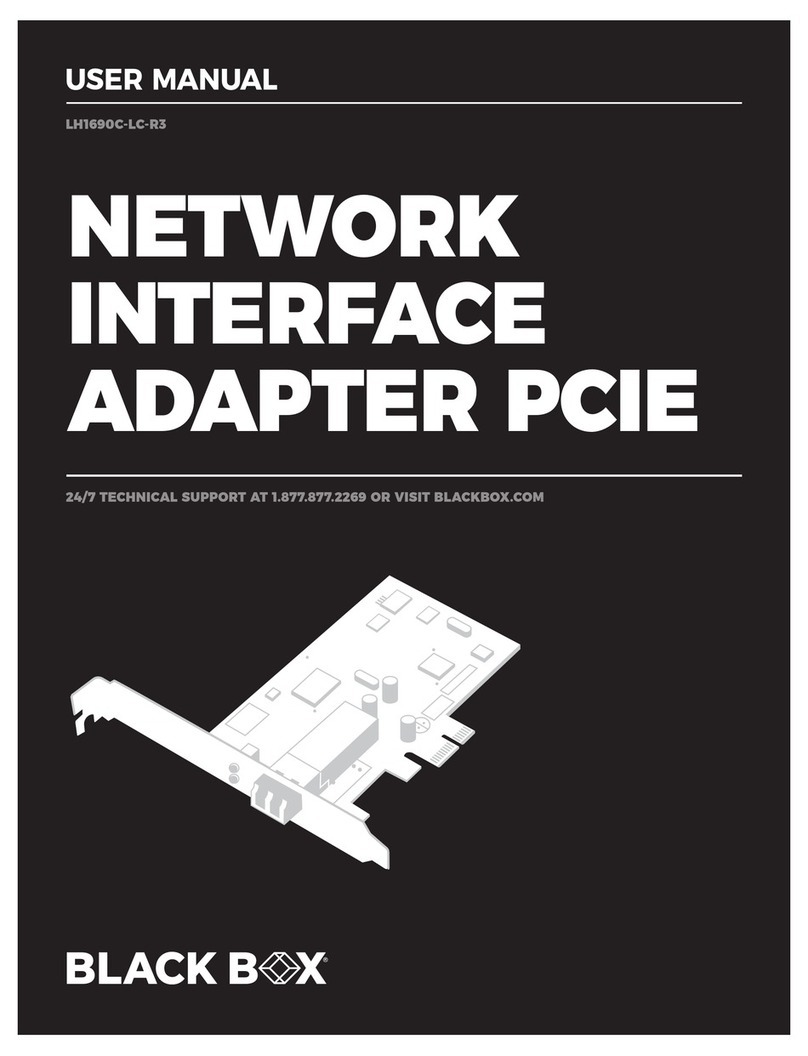
Black Box
Black Box LH1690C-LC-R3 User manual
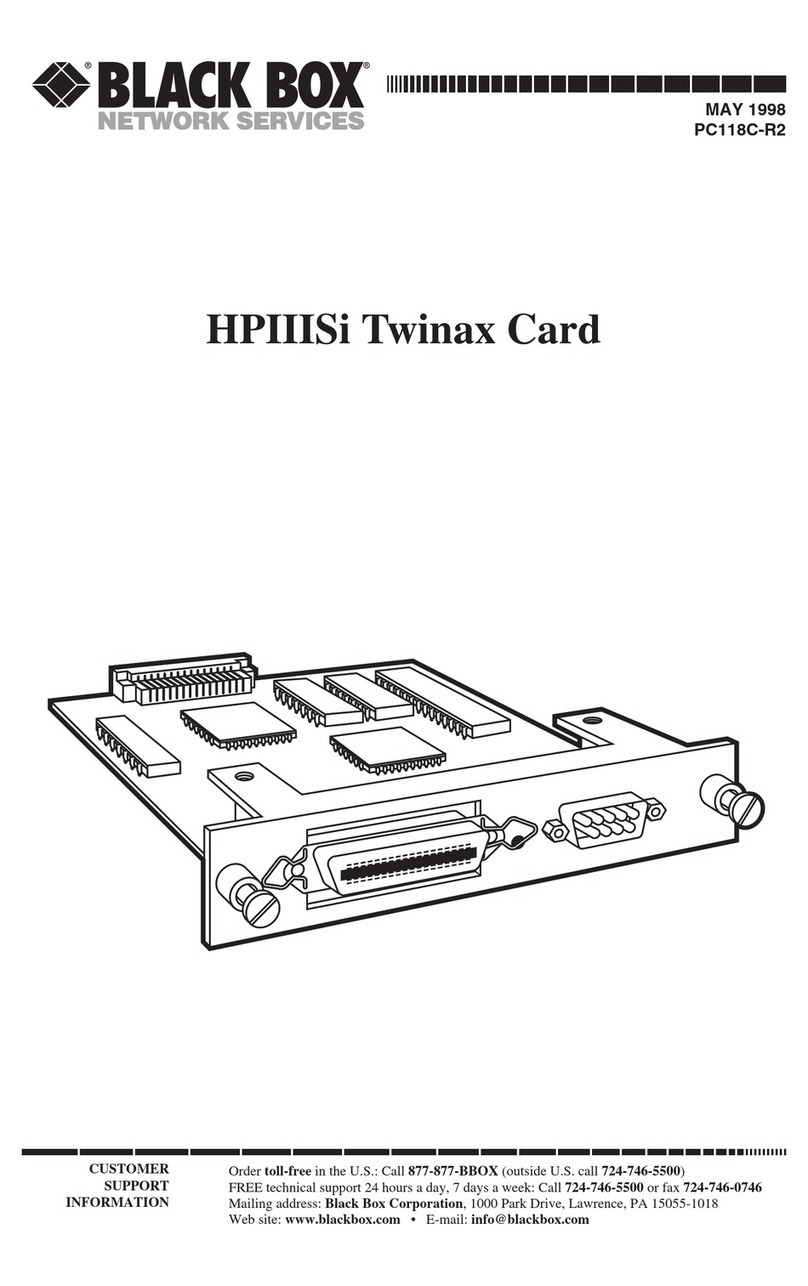
Black Box
Black Box PC118C-R2 User manual

Black Box
Black Box LDL-MR19.2 User manual
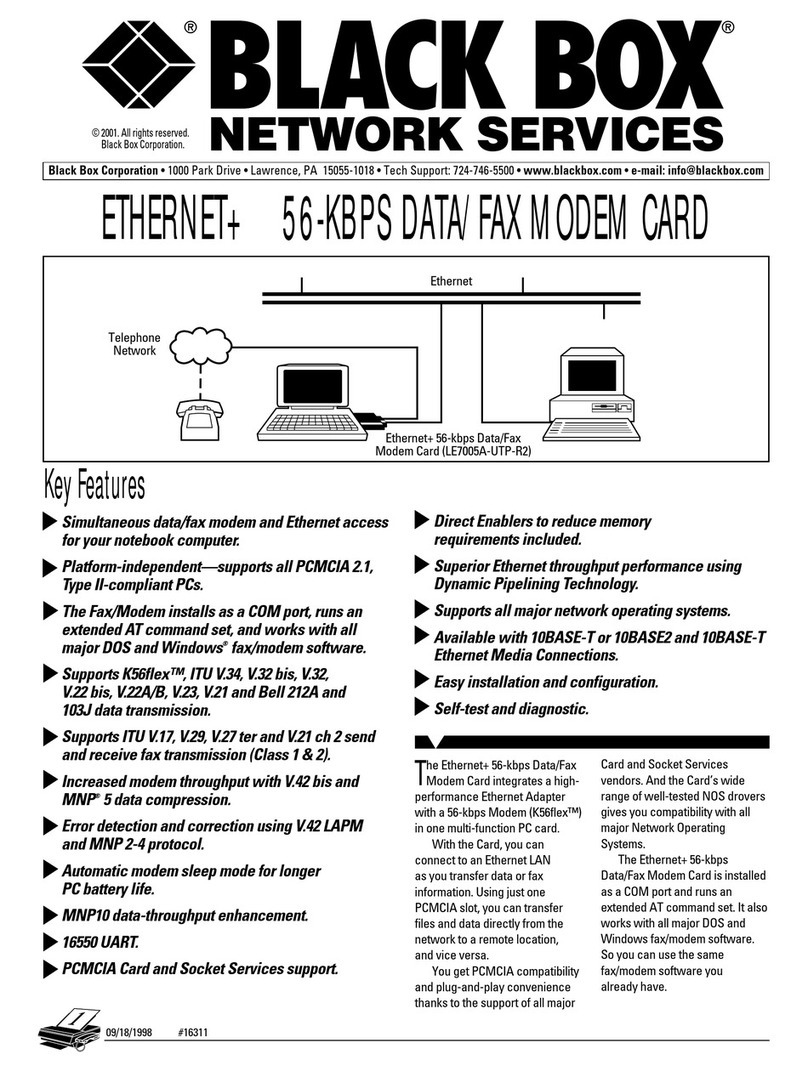
Black Box
Black Box LE7005A-UTP-R2 User manual

Black Box
Black Box CityLIGHT LCL533A User manual
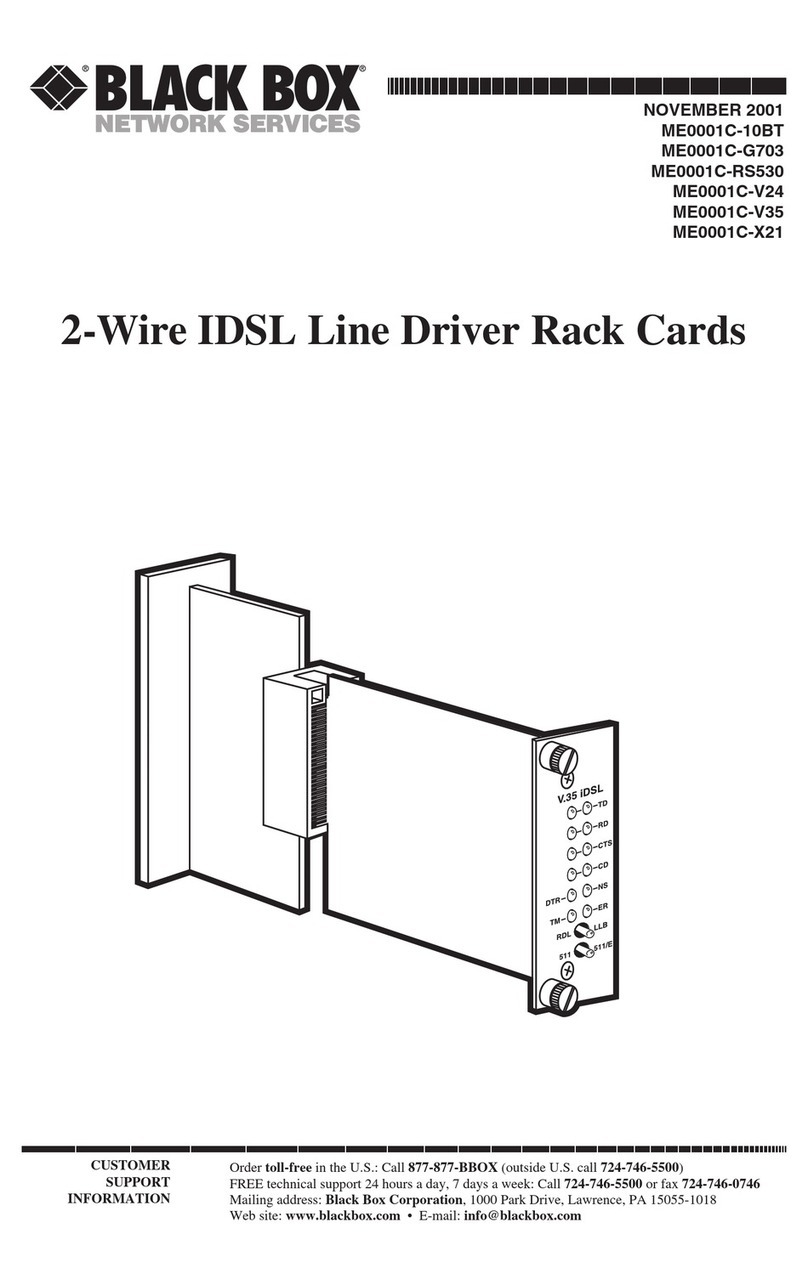
Black Box
Black Box ME0001C-10BT User manual

Black Box
Black Box DSL LAN Extender 400 User manual
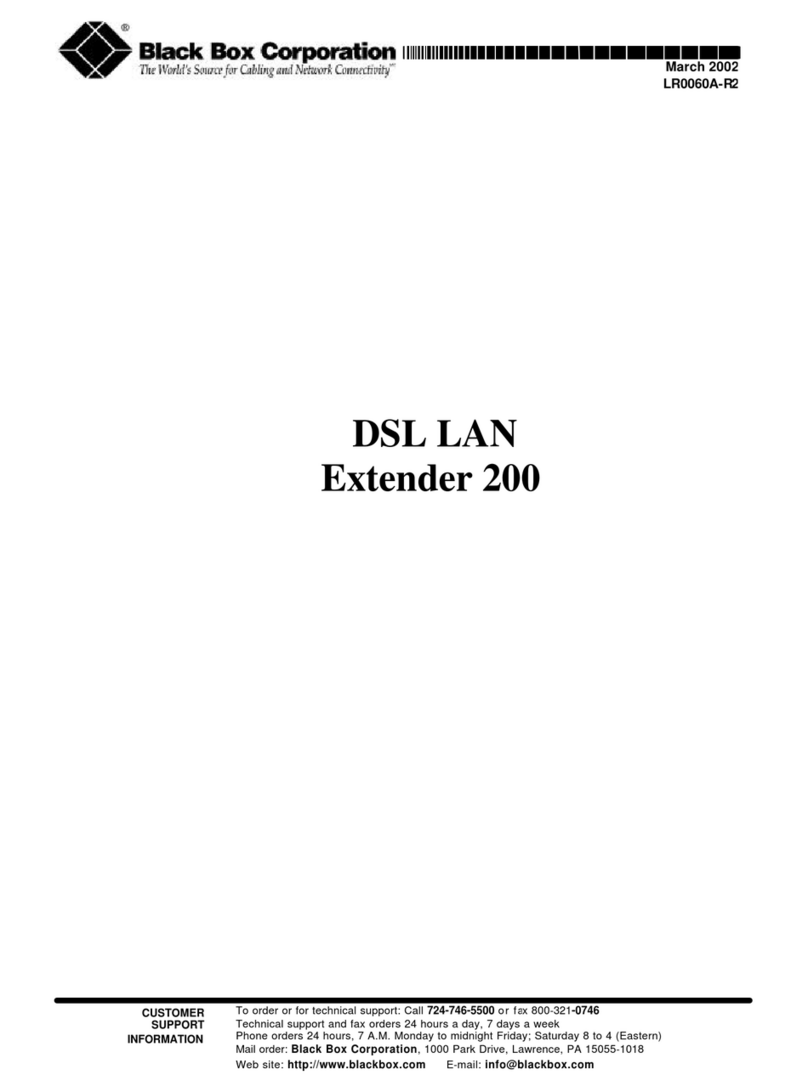
Black Box
Black Box DSL LAN Extender 200 User manual
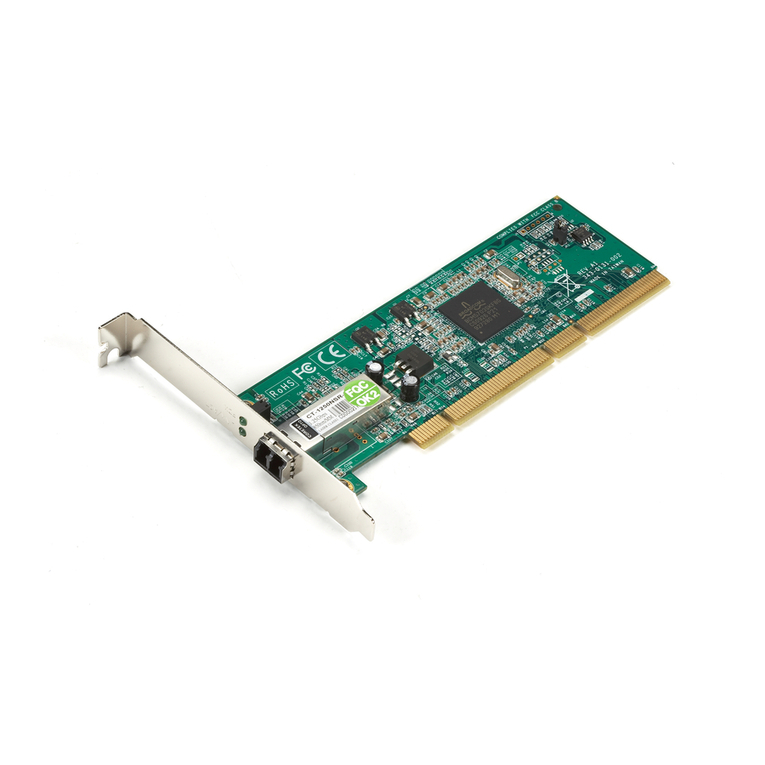
Black Box
Black Box LH1660C-SC User manual
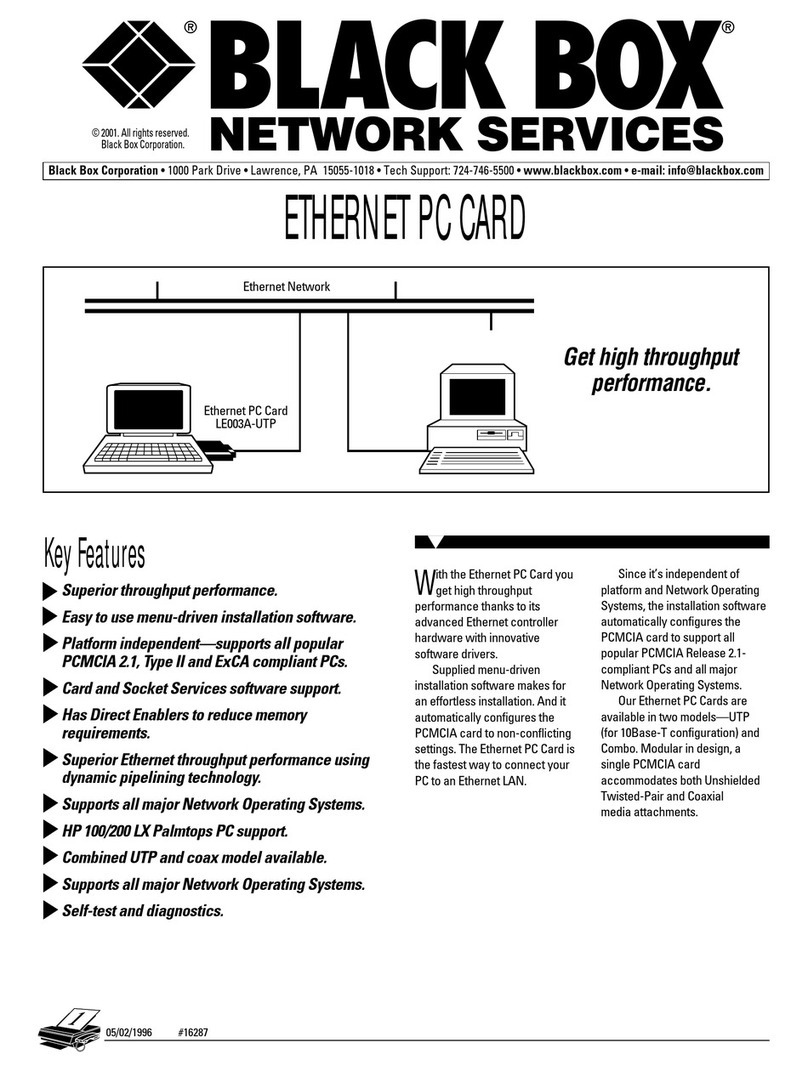
Black Box
Black Box LE7003A User manual


